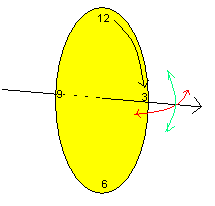My question has to do with whether the diaphragm of a side-address condenser picks up sound evenly on all 360 degrees, or if it "hears" best in the upright position relative to a source.
http://img184.image…"]  [/]="http://img184.image…"]
[/]="http://img184.image…"]  [/]
[/]
Assume that sound is coming toward this mic's front (on the Z-axis): Will rotating the mic to any degree as per the diagram alter what the diaphragm "hears", either due to 1.) microphone resonance or 2.) X-/Y-Axis favoritism?
Another example: imagine the above microphone on the sweet spot of a guitar amp. Will rotating it 90 degress on the X-axis still produce the same sound IF the diaphragm is in the same location (albeit rotated)? I know this is remedial stuff, but my spatial-temporal faculties are lacking and it'd be a time saver to get a clear answer on this.
Comments
If the pivot point were the center of the capsule wouldn't it e
If the pivot point were the center of the capsule wouldn't it essentially be the same? If you were to move the microphone in a circular pattern with the point where the mic clip meets the mic as the axis in place of a pivot point, wouldn't this be the same as rotating the mic around that pivot point?
The Emag article was a real nice piece on one of my favorite eng
The Emag article was a real nice piece on one of my favorite engineer/producers but did little to answer the question.
The answer is, on your X/Y axis with the front of a mic (capsule area)aimed at the source, and in cardioid pattern , there is no shedding of the sound in reference to the position other than 'tilt' of the diaphram in relation to the source.
So, no, it will not make a difference in frequency response or strength of signal.
Unless you rotate it so the capsule is 'off axis' to the source.
This is one way to effectively capture a sound and use the mics natural frequency response to EQ without resorting to the use of a knob. This will ALWAYS produce a signal with a lower noise floor than one attained by adding another link in the chain.
My fellow Mod, BenT is very specific on this and has mentioned it a number of times .
The lesson is, once again, 'Why we learn what the size and shape of our polar patterns on the mics are, and what frequencies are effected by the limits of these patterns'. A burst chart will indicate this to some accuracy, depending upon the test methods used and the manufacturers' desire for accuracy.
(I see Davedog beat me to the punch here, but I already wrote th
(I see Davedog beat me to the punch here, but I already wrote this, so might as well post it...)
That article doesn't say anything about the kind of rotation Patrick asked about. He put one mic straight on to the amp and another angled at 45 degrees to the amp. Great, but not relevant to this discussion.
Rotating about the x-axis as Patrick described it (imagine the diaphragm as a circular target with an arrow in the bullseye, and spinning the target around the arrow) shouldn't have any discernable effect at all.
Thanks for the responses, guys. Dave, MW, and hueseph: I starte
Thanks for the responses, guys. Dave, MW, and hueseph: I started posting a huge-long response until I realized that this question is dumb. I just couldn't piece it together in my brain.
The sound a microphone receives is picked up from all points evenly across the face of the diaphragm, rather than being stronger running 12-to-6 o'clock, or 3-to-9 o' clock, right?
I gotta jump in here with a silly (albeit true) statement. I on
I gotta jump in here with a silly (albeit true) statement.
I once worked with a guy that swore up and down if you had one mic pointed "right side up" (i.e. a 57 with XLR pins 1&2 at the top), and another with pin 3 at the top (spun 180 degrees "upside down") but still pointed in the same exact direction, they would be out of phase!
:lol:
Unless there are some wierd microphones I don't know about, you
Unless there are some wierd microphones I don't know about, you are correct that the response is symmetric around the face. It is when you rotate along the green or red arrows in the crude diagram below that you get different response. The sensitivity and frequency response patterns (cardiod, omni, figure 8, etc) refer to motion along those paths (either one, since the "clock" rotation doesn't matter). That's where the 45 degrees quoted in the article applies, not to rotating from 12 o'clock to 1:30.





This is an article from EQ mag with the man, Andy Johns, who use
This is an article from EQ mag with the man, Andy Johns, who used to mic Jimi Hendrix's guitar amp. He speaks about your question.
Louder Than A Bomb
http://www.eqmag.com/article/louder-than-a/Jun-05/10578